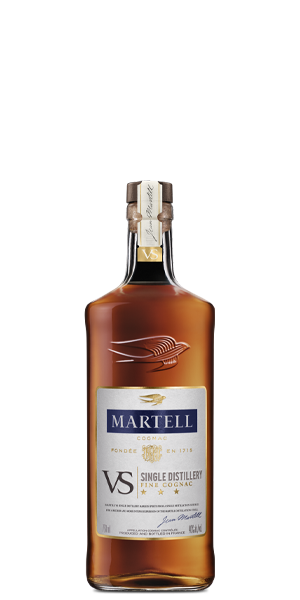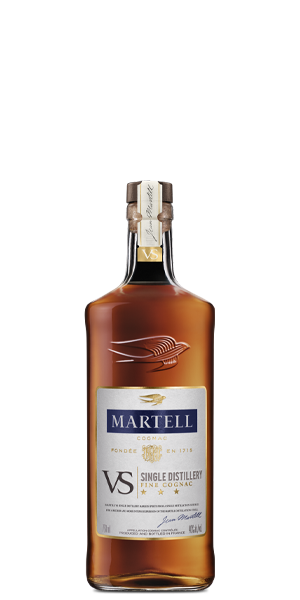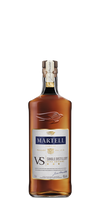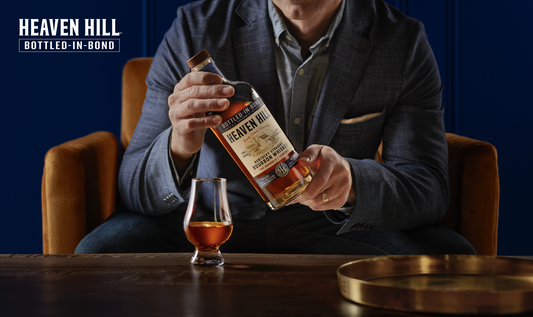Martell V.S. Single Distillery Cognac
Martell V.S. Single Distillery Cognac
Size: 0,75
l
(40.0%
ABV)
$37.99
Quantity
View full details
Couldn't load pickup availability
- BrandMartell
- CategoryCognac
- CountryFrance
- RegionCognac
- DistilleryMartell
- Style Cognac
- Alcohol40.0%
Cranking up the signature Martell distillation process style? Gimme!
If you make anything for over three centuries, chances are you are pretty damn good at it. House Martell is the eldest of the major Cognac houses. Founded in 1715 by Jean Martell along the banks of the Charente, at the pinnacle of the French "L’Art de Vivre." The French basically have this way of living, where they believe in embracing all of the good stuff life has to offer. Martell Cognac is definitely the good stuff, with a full range of expressions for us to indulge in. La vie est belle, d’accord? Cheers to House Martell.
The young Briton put himself on the map by marrying into "Cognac royalty" not once, but twice! His second marriage was to Jeanne-Rachel Lallemand, "a direct descendant of Jacques Roux, a pioneering 17th century Cognac merchant," by the 19th century, Martell had become the biggest international exporter of Cognac in the world, reaching as far as China and Japan.
Martell VS Single Distillery is a marriage of Spirits from a single distillation source in the Cognac region. This means a richer and more intense expression of the Martell distillation process. (Basically, a Martell that's high in Martell!) The iconic Martell style of double distilling exclusively clear Wines to preserve the fruity aromas is taken to new heights. Aged for 2 years in oak barrels and bottled at 80 proof, the delicate aromas of grapes and luscious fruity aromas immediately let you know this is the real Martell.
If you make anything for over three centuries, chances are you are pretty damn good at it. House Martell is the eldest of the major Cognac houses. Founded in 1715 by Jean Martell along the banks of the Charente, at the pinnacle of the French "L’Art de Vivre." The French basically have this way of living, where they believe in embracing all of the good stuff life has to offer. Martell Cognac is definitely the good stuff, with a full range of expressions for us to indulge in. La vie est belle, d’accord? Cheers to House Martell.
The young Briton put himself on the map by marrying into "Cognac royalty" not once, but twice! His second marriage was to Jeanne-Rachel Lallemand, "a direct descendant of Jacques Roux, a pioneering 17th century Cognac merchant," by the 19th century, Martell had become the biggest international exporter of Cognac in the world, reaching as far as China and Japan.
Martell VS Single Distillery is a marriage of Spirits from a single distillation source in the Cognac region. This means a richer and more intense expression of the Martell distillation process. (Basically, a Martell that's high in Martell!) The iconic Martell style of double distilling exclusively clear Wines to preserve the fruity aromas is taken to new heights. Aged for 2 years in oak barrels and bottled at 80 proof, the delicate aromas of grapes and luscious fruity aromas immediately let you know this is the real Martell.
Flavor Spiral TM
Appearance / Color
Bright gold
Nose / Aroma / Smell
Plum, apricot and candied lemon.
Flavor / Taste / Palate
Rich, fruity notes. Luscious mouthfeel.
Finish
Long and slightly sweet.
Bright gold
Nose / Aroma / Smell
Plum, apricot and candied lemon.
Flavor / Taste / Palate
Rich, fruity notes. Luscious mouthfeel.
Finish
Long and slightly sweet.
About
Cranking up the signature Martell distillation process style? Gimme!
If you make anything for over three centuries, chances are you are pretty damn good at it. House Martell is the eldest of the major Cognac houses. Founded in 1715 by Jean Martell along the banks of the Charente, at the pinnacle of the French "L’Art de Vivre." The French basically have this way of living, where they believe in embracing all of the good stuff life has to offer. Martell Cognac is definitely the good stuff, with a full range of expressions for us to indulge in. La vie est belle, d’accord? Cheers to House Martell.
The young Briton put himself on the map by marrying into "Cognac royalty" not once, but twice! His second marriage was to Jeanne-Rachel Lallemand, "a direct descendant of Jacques Roux, a pioneering 17th century Cognac merchant," by the 19th century, Martell had become the biggest international exporter of Cognac in the world, reaching as far as China and Japan.
Martell VS Single Distillery is a marriage of Spirits from a single distillation source in the Cognac region. This means a richer and more intense expression of the Martell distillation process. (Basically, a Martell that's high in Martell!) The iconic Martell style of double distilling exclusively clear Wines to preserve the fruity aromas is taken to new heights. Aged for 2 years in oak barrels and bottled at 80 proof, the delicate aromas of grapes and luscious fruity aromas immediately let you know this is the real Martell.
If you make anything for over three centuries, chances are you are pretty damn good at it. House Martell is the eldest of the major Cognac houses. Founded in 1715 by Jean Martell along the banks of the Charente, at the pinnacle of the French "L’Art de Vivre." The French basically have this way of living, where they believe in embracing all of the good stuff life has to offer. Martell Cognac is definitely the good stuff, with a full range of expressions for us to indulge in. La vie est belle, d’accord? Cheers to House Martell.
The young Briton put himself on the map by marrying into "Cognac royalty" not once, but twice! His second marriage was to Jeanne-Rachel Lallemand, "a direct descendant of Jacques Roux, a pioneering 17th century Cognac merchant," by the 19th century, Martell had become the biggest international exporter of Cognac in the world, reaching as far as China and Japan.
Martell VS Single Distillery is a marriage of Spirits from a single distillation source in the Cognac region. This means a richer and more intense expression of the Martell distillation process. (Basically, a Martell that's high in Martell!) The iconic Martell style of double distilling exclusively clear Wines to preserve the fruity aromas is taken to new heights. Aged for 2 years in oak barrels and bottled at 80 proof, the delicate aromas of grapes and luscious fruity aromas immediately let you know this is the real Martell.
Read More
- BrandMartell
- CategoryCognac
- CountryFrance
- RegionCognac
- DistilleryMartell
- Style Cognac
- Alcohol40.0%
Flavor Spiral TM
Appearance / Color
Bright gold
Nose / Aroma / Smell
Plum, apricot and candied lemon.
Flavor / Taste / Palate
Rich, fruity notes. Luscious mouthfeel.
Finish
Long and slightly sweet.
Bright gold
Nose / Aroma / Smell
Plum, apricot and candied lemon.
Flavor / Taste / Palate
Rich, fruity notes. Luscious mouthfeel.
Finish
Long and slightly sweet.

Customer Reviews
Based on 31 reviews
Write a review














